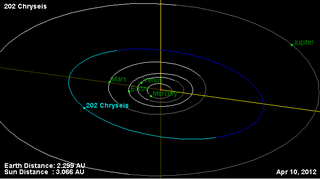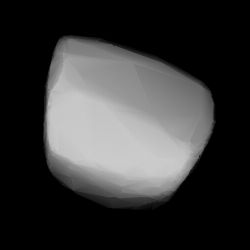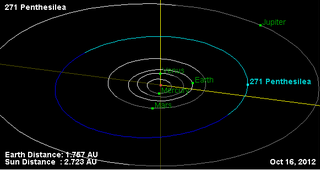
Dejanira is a main belt asteroid that was discovered by Alphonse Borrelly on 1 December 1875, and named after the warlike princess Deianira in Greek mythology. The Dejanira family of asteroids is named after it.

Chryseïs is a large, lightly coloured Main belt asteroid that is probably composed of silicate rocks. It was discovered by C. H. F. Peters on September 11, 1879, in Clinton, New York, and was named after the mythical Trojan woman Chryseis.

Pompeja is a quite large main-belt asteroid. It was discovered by C. H. F. Peters on September 25, 1879, in Clinton, New York, and named after Pompeii, the Roman town destroyed in volcanic eruption in AD 79. This asteroid is orbiting the Sun at a distance of 2.74 AU with an eccentricity (ovalness) of 0.06 and a period of 4.53 yr. The orbital plane is tilted at an angle of 3.2° to the plane of the ecliptic.

Hedda is a sizeable Main belt asteroid. It is a C-type asteroid, meaning it is primitive in composition and dark in colour. This asteroid was discovered by Johann Palisa on October 17, 1879, in Pola and was named after Hedwig Winnecke, wife of astronomer Friedrich A. T. Winnecke.

Philosophia is a large main-belt asteroid that was discovered by the French astronomer Paul-Pierre Henry on August 12, 1882, in Paris and named after the topic of philosophy. Based upon photometric observations, it has a synodic rotation period of 52.98 ± 0.01 with a brightness variation of 0.15 ± 0.02 in magnitude.

Agathe is a stony main belt asteroid, about 9 kilometers in diameter. It was discovered by Johann Palisa on 19 August 1882 at Vienna Observatory, Austria. Photometric observations during 2003 showed a rotation period of 6.48 ± 0.01 hours with a brightness variation of 0.27 ± 0.03 in magnitude. An earlier study yielded results that are consistent with these estimates. Agathe is the lowest numbered asteroid to have an Earth-MOID as low as 0.657 AU (98.3 million km). On 23 August 2029 the asteroid will be 0.659 AU (98.6 million km) from Earth.
Russia is a large Main belt asteroid. It is classified as a C-type asteroid and is probably composed of primitive carbonaceous material. It was discovered by Johann Palisa on 31 January 1883 in Vienna, who named it after the country of Russia.

Adrastea is a main belt asteroid. It was discovered by Johann Palisa on 18 August 1884 in Vienna, and was named after the Greek nymph Adrasteia. This asteroid is orbiting the Sun at a distance of 2.97 AU with a period of 5.11 years and an eccentricity (ovalness) of 0.23. The orbital plane is tilted at an angle of 6.17° to the plane of the ecliptic.

Vanadis is a fairly large main-belt asteroid with a diameter of around 100 km. It was discovered by A. Borrelly on August 27, 1884, in Marseilles and was named after Freyja (Vanadis), the Norse fertility goddess. The asteroid is orbiting the Sun at a distance of 2.67 AU with a period of 4.35 yr and an orbital eccentricity of 0.206. The orbital plane is inclined at an angle of 2.10° to the plane of the ecliptic.

Vera is a large Main belt asteroid. It was discovered by N. R. Pogson on February 6, 1885, in Madras, and was named at the suggestion of his wife. The asteroid is orbiting the Sun at a distance of 3.11 AU with a period of 5.47 years and an eccentricity (ovalness) of 0.19. The orbital plane is tilted at an angle of 5.16° to the plane of the ecliptic. In 1890, Daniel Kirkwood noted that this asteroid shares similar orbital elements with 86 Semele and 106 Dione.

Penthesilea is a mid-sized main belt asteroid that was discovered by Viktor Knorre on 13 October 1887 in Berlin. It was his last asteroid discovery. The asteroid was named after Penthesilea, the mythical Greek queen of the Amazons.

Lucretia is an asteroid belonging to the Flora family in the Main Belt. It was discovered by Austrian astronomer Johann Palisa on 31 October 1888 in Vienna, and is named after the middle name of Caroline Herschel, one of the first female astronomers. Light curves of this asteroid show a synodic rotation period of 4.349±0.001 h with an amplitude of 0.3–0.4 magnitude. The spin axis appears nearly perpendicular to the ecliptic.

Iclea is a large main belt asteroid with the minor planet designation, 286 Iclea. It was discovered by Austrian astronomer Johann Palisa on 3 August 1889 in Vienna, and named for the heroine of Camille Flammarion's astronomical romance Uranie. This object is orbiting the Sun at a distance of 3.19 AU with a period of 5.711 years and an orbital eccentricity (ovalness) of 0.029. The orbital plane is tilted at an angle of 17.9° to the plane of the ecliptic.

Thora is a 17 km Main belt asteroid with a potentially long 274-hour rotation period. It was discovered by Johann Palisa on 6 October 1890 in Vienna.

Fraternitas is a typical Main belt asteroid. It was discovered by Johann Palisa on 6 April 1891 in Vienna. The asteroid name is Latin for 'fraternity'; it was so named in order to commemorate the 25th anniversary of the Maturitätsprüfung Fraternity.
Kilia is a 27 km main-belt asteroid discovered on 21 April 1901 by Luigi Carnera at Heidelberg, the 470th asteroid discovered. It was one of the 16 asteroid discoveries made by Carnera.
801 Helwerthia is a C-type asteroid orbiting in the Main belt near the Eunomia family. However, it is not a family member but an un-related interloper in the region because its composition is inconsistent with membership. Its diameter is about 33 km, its albedo around 0.038. An international team of astronomers observed this minor planet photometrically in 2012, determining a rotation period of 23.93±0.01 h with an amplitude of 0.15±0.03 in magnitude.
999 Zachia is a main-belt asteroid that was discovered by German astronomer Karl W. Reinmuth in 1923 and named after Hungarian astronomer Franz Xaver von Zach.
2311 El Leoncito, provisional designation 1974 TA1, is a dark and reddish asteroid from the outer region of the asteroid belt, approximately 53 kilometers in diameter. The asteroid was discovered by astronomers at Félix Aguilar Observatory at the Leoncito Astronomical Complex in Argentina on 10 October 1974. It was later named after the discovering site.
(523645) 2010 VK201, provisional designation 2010 VK201, is a trans-Neptunian object and member of the classical Kuiper belt, approximately 500 kilometers (310 miles) in diameter. It was discovered on 1 November 2010, by the Pan-STARRS 1 survey at Haleakala Observatory, Hawaii, United States. It has a rotation period of 7.6 hours. It was numbered in September 2018 and remains unnamed.














